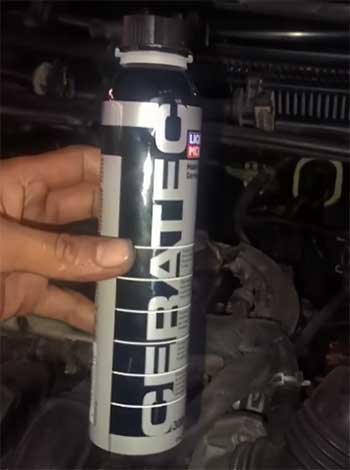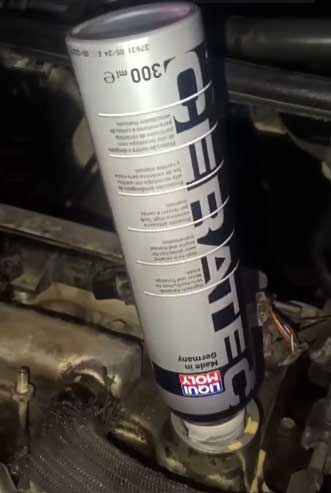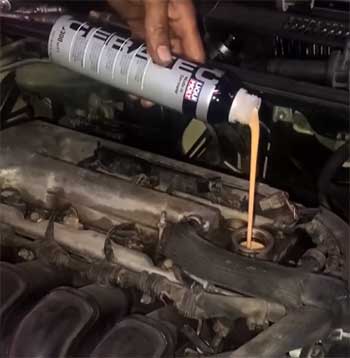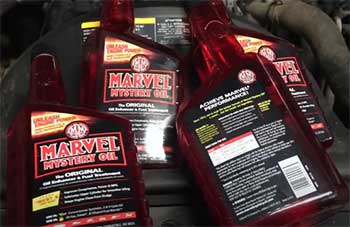As a car enthusiast, I was thrilled to try Liqui Moly Cera Tec in my 2015 VW Golf GTI, lured by promises of a smoother, quieter engine and better fuel economy. But my experience, combined with user feedback, revealed some serious drawbacks.
In this article, I’ll share my journey, analyzing Cera Tec’s problems like fading effects and potential warranty issues. My goal is to give you a clear, engaging, and honest breakdown so you can decide if this additive is worth it for your ride or if alternatives are a better bet.
List of Common Cera Tec Problems
Before I unpack each issue, here’s a quick rundown of the main problems reported with Liqui Moly Cera Tec:
- Diminishing effects after oil changes
- Potential spark plug fouling
- Risk of engine sludge buildup
- Possible warranty voiding
- Limited effectiveness in high-mileage or poorly maintained engines
Understanding Liqui Moly Cera Tec

Liqui Moly Cera Tec is a premium oil additive designed to reduce friction and wear in petrol and diesel engines.
Its key feature is a microceramic solid lubricant, hexagonal boron nitride, suspended in a base oil with chemical anti-wear agents.
The ceramic particles are supposed to fill in microscopic imperfections in engine metal surfaces, creating a smoother, low-friction environment.
The manufacturer claims this leads to quieter operation, better fuel efficiency, and protection for up to 50,000 km (30,000 miles).
It’s marketed for 4-stroke engines, manual transmissions, pumps, and compressors, and is compatible with most motor oils, catalytic converters, and particulate filters.
I was drawn to Cera Tec because of its high-tech appeal.
The idea of ceramic particles coating my engine’s internals sounded like something out of a sci-fi movie. Plus, Liqui Moly is a reputable brand, and I’d had good experiences with their oils before.
But as I started using it and researching user feedback, I noticed a pattern of issues that made me question its universal praise.
Problem 1: Diminishing Effects After Oil Changes
One of the first issues I encountered was the fleeting nature of Cera Tec’s benefits. After adding it to my GTI’s fresh oil, I noticed an immediate difference. The engine felt smoother, and the usual ticking noise at idle was noticeably quieter.
It was like the car had been given a shot of espresso—everything just seemed to run better. But after my next oil change, about 5,000 miles later, that smoothness vanished. The engine reverted to its pre-Cera Tec behavior, and I was left wondering if I’d imagined the whole thing.
This isn’t just my experience. Many users on forums like Team-BHP and Reddit report that Cera Tec’s effects—smoother operation, reduced noise, and improved fuel economy—fade after an oil change.
The product’s long-term claim of 30,000 miles seems misleading because most of us change our oil far more frequently, typically every 5,000 to 10,000 miles. Once the old oil is drained, much of the additive goes with it, and you’re back to square one unless you add another bottle, which costs around $25-$30 a pop. For a product that’s supposed to last 30,000 miles, this feels like a bait-and-switch.
The science behind this makes sense. Cera Tec’s ceramic particles are suspended in the oil, not permanently bonded to engine surfaces. When you drain the oil, you’re likely removing a significant portion of those particles.
Some users argue that the chemical agents leave a lasting coating, but there’s little evidence to support that this coating survives multiple oil changes. If you’re meticulous about oil changes like I am, you might find yourself shelling out for Cera Tec more often than you’d like.
Problem 2: Potential Spark Plug Fouling

Another concern that raised my eyebrows was the risk of spark plug fouling.
This issue came up in discussions on automotive forums like BobIsTheOilGuy, where users speculated that Cera Tec could leave deposits on spark plugs, especially in petrol engines.
In my case, I didn’t notice any misfiring or performance issues that would point to fouled plugs, but I decided to pull a spark plug after 3,000 miles to check.
Sure enough, there was a slight buildup of residue—not enough to cause problems, but enough to make me cautious.
The worry here stems from Cera Tec’s ceramic particles.
If an engine burns oil, even slightly, those particles can end up in the combustion chamber, potentially sticking to spark plugs.
While Liqui Moly’s representatives have dismissed this concern, stating that any issues would come from the oil itself and not Cera Tec, the possibility still looms.
For high-mileage engines or those with worn seals, this could be a real problem. I’ve read reports of users with older vehicles noticing misfires after using Cera Tec, though these are rare and often tied to improper use, like adding too much additive.
To be safe, I’d recommend checking your spark plugs periodically if you use Cera Tec, especially if your engine has over 100,000 miles. It’s not a dealbreaker, but it’s something to keep an eye on, particularly if your car isn’t in pristine condition.
Problem 3: Risk of Engine Sludge Buildup
Sludge buildup is another issue that gave me pause. On forums like Reddit’s r/GolfGTI, some users have shared horror stories about Cera Tec clogging oil passages or contributing to sludge in neglected engines.
One user even claimed it starved their camshafts by clogging “veins,” though this seems like an extreme case. In my GTI, I didn’t notice any sludge-related issues, but I’m religious about maintenance, and my car had a clean bill of health before I added Cera Tec.
The concern about sludge likely comes from Cera Tec’s viscosity-increasing properties. Some users on Team-BHP noted that it thickens the oil, which could be problematic in engines already prone to sludge due to infrequent oil changes or poor maintenance. If your engine has existing deposits, adding Cera Tec might exacerbate the problem rather than solve it.
Liqui Moly advises using Cera Tec with fresh oil and a clean engine, but not every car owner has the luxury of a spotless engine bay.
Before using Cera Tec, I ran a Liqui Moly engine flush to clear out any gunk, which might explain why I avoided this issue. If you’re considering Cera Tec, I’d strongly suggest doing the same or at least ensuring your engine is in good shape. For cars that have been neglected, the risk of sludge could outweigh the benefits.
Problem 4: Possible Warranty Voiding
One of the most frustrating discoveries was the potential for Cera Tec to void your vehicle’s warranty. This wasn’t something I considered initially, but after digging into manufacturer guidelines, I found that many automakers, including Volkswagen, frown upon aftermarket additives.
The concern is that additives like Cera Tec could alter the oil’s properties, potentially causing issues that the manufacturer could then blame on the additive rather than a covered defect.
On my GTI, which was still under an extended warranty, I contacted my dealer to ask about Cera Tec. The service advisor was blunt: “Use it, and we might deny a claim if something goes wrong with the engine.”
That was enough to make me think twice. Online, users on Detailing World and other forums have echoed this sentiment, noting that some manufacturers explicitly warn against additives to avoid warranty disputes.
Liqui Moly claims Cera Tec is safe and compatible with most oils, but that doesn’t mean your manufacturer will agree. If your car is still under warranty, check with your dealer or read the fine print in your owner’s manual before pouring in Cera Tec. The last thing you want is a denied claim over a $30 bottle of additive.
Problem 5: Limited Effectiveness in High-Mileage or Poorly Maintained Engines

Finally, I noticed that Cera Tec’s effectiveness seems to vary depending on the engine’s condition.
My GTI, with 60,000 miles and regular maintenance, responded well initially.
But users with high-mileage vehicles—say, over 150,000 miles—or engines with existing wear report mixed results.
On Reddit’s r/TDI, one user with a 110,000-mile Golf TDI saw reduced oil consumption after using Cera Tec, but another with a worn engine said it made no difference.
The issue here is that Cera Tec isn’t a repair product. It’s designed to reduce friction and wear, not fix existing damage.
If your engine has worn piston rings, scored cylinders, or other issues, Cera Tec won’t magically restore it.
In fact, some users report that it can make sluggish engines feel even worse, possibly due to the increased viscosity. One user on a Hyundai forum mentioned their car felt “heavier” after adding Cera Tec, which aligns with reports of it not being ideal for engines already struggling.
For me, this was a reminder that Cera Tec works best as a preventative measure in well-maintained engines. If your car’s seen better days, you might not get the promised benefits, and you could even run into problems like sludge or reduced performance.
My Personal Take: Weighing the Pros and Cons
Using Cera Tec was a mixed bag. The initial smoothness and quieter operation were undeniable, and I even saw a slight bump in fuel economy—about 1-2 mpg on my usual commute. But the fact that those benefits disappeared after an oil change was a letdown.
The potential for spark plug fouling, sludge buildup, and warranty issues made me question whether it was worth the cost and risk. For a well-maintained car like mine, Cera Tec offered some perks, but it’s not a game-changer, and the problems I’ve outlined are real enough to make me hesitant about using it regularly.
If you’re considering Cera Tec, I’d say it’s best for newer or well-maintained vehicles where you’re looking to enhance performance rather than fix problems. Be diligent about following the instructions—use it with fresh oil, don’t overfill, and avoid it in engines with wet clutches or automatic transmissions.
And if your car is under warranty, double-check with your manufacturer to avoid headaches down the road.
Alternatives To Liqui Moly Cera Tec
If you’re on the fence about Cera Tec, there are other additives that might suit your needs without the same concerns. Here are five alternatives worth considering:
- Liqui Moly MoS2 Anti-Friction Additive
This is Liqui Moly’s older, molybdenum disulfide-based additive. It’s cheaper than Cera Tec and has a solid reputation for reducing friction, especially in older engines. Users on Reddit’s r/GolfGTI praise it for quieting noisy engines without the viscosity issues of Cera Tec. - BG 109 Engine Flush
If you’re worried about sludge, BG 109 is a cleaning additive that flushes out deposits before an oil change. It’s not a friction reducer like Cera Tec, but it’s great for preparing your engine for a fresh oil fill, potentially avoiding the sludge risks associated with Cera Tec. - Lucas Oil Heavy Duty Oil Stabilizer
Lucas Oil’s additive is designed to reduce wear and noise in high-mileage engines. It’s thicker than Cera Tec, which can help with oil leaks, but it’s less likely to cause spark plug fouling. Users on Amazon report good results in older vehicles. - Red Line Oil Break-In Additive
This additive focuses on zinc (ZDDP) to protect high-performance engines. It’s ideal for flat-tappet cams and older engines, offering wear protection without the ceramic particles that might clog passages. It’s a favorite on BobIsTheOilGuy for its proven track record. - Archoil AR9100 Oil Additive
Archoil uses nanoborate technology to reduce friction and clean engine deposits. It’s less likely to increase viscosity, making it safer for high-mileage engines. Users on automotive forums note improved performance and reduced oil consumption.
Frequently Asked Questions (FAQ)
No, there’s no definitive evidence that Cera Tec clogs oil filters when used correctly. However, in engines with existing sludge, it could contribute to buildup, so ensure your engine is clean before use.
It can be beneficial for well-maintained engines, reducing friction and noise. But it’s not a fix for existing damage, and improper use may lead to issues like sludge or warranty disputes.
Effects like smoother operation and reduced noise are often noticeable within 50-200 miles of driving, though results vary by engine condition.
Yes, Cera Tec is safe for turbocharged engines, as confirmed by Liqui Moly. It’s compatible with turbo systems and won’t harm seals or bearings when used as directed.
Conclusion: Is Cera Tec Worth It For You?
You’ve seen my journey with Liqui Moly Cera Tec—the highs of a smoother, quieter engine and the lows of fading effects and potential risks. While it’s not a bad product, it’s not the universal solution it’s sometimes made out to be.
If you’re driving a well-maintained car and don’t mind the cost of reapplying it every oil change, Cera Tec can add a bit of polish to your engine’s performance. But if your ride’s got high miles, a questionable maintenance history, or a warranty you want to protect, you might want to think twice or explore alternatives.
For me, the jury’s still out. I’m leaning toward sticking with a high-quality synthetic oil and maybe a less controversial additive like Liqui Moly’s MoS2 for my next oil change. What about you? Have you tried Cera Tec, or are you considering it?
Weigh your engine’s condition, your maintenance habits, and your budget before deciding. If you do go for it, keep an eye on your spark plugs, stick to the instructions, and don’t expect miracles. Your car deserves the best, so choose wisely.

